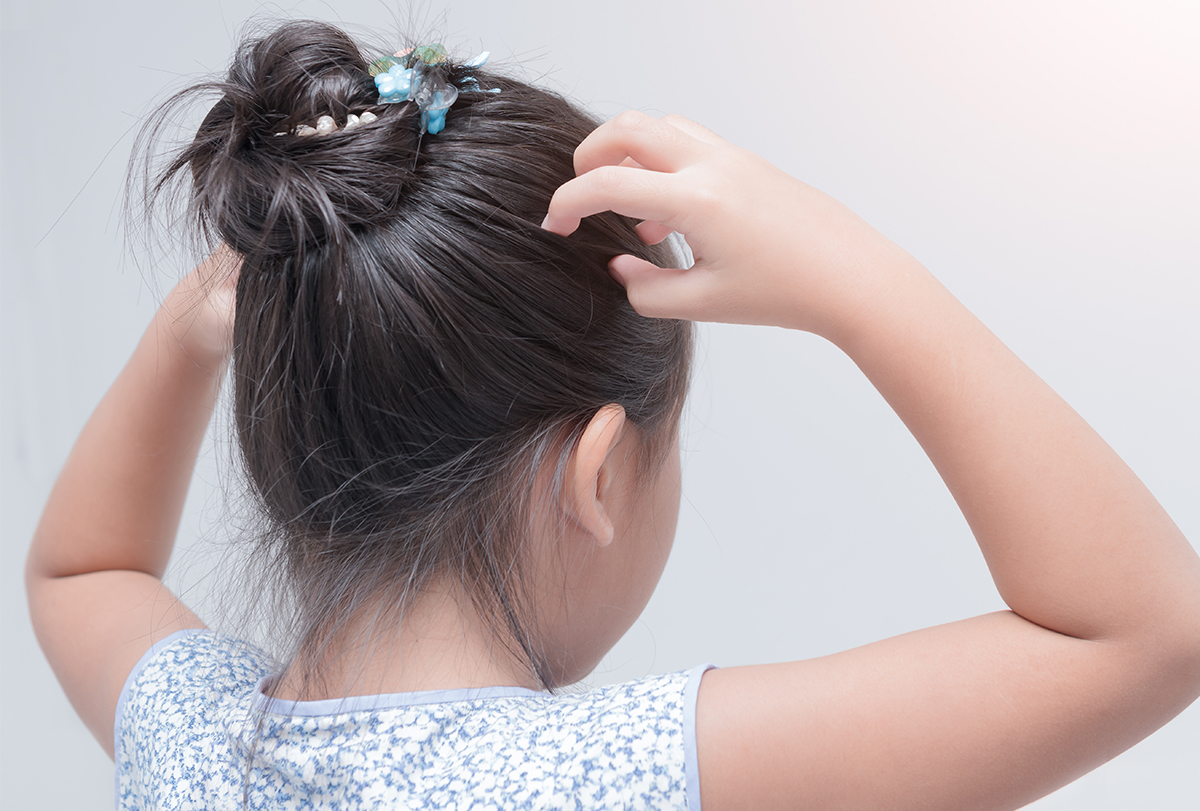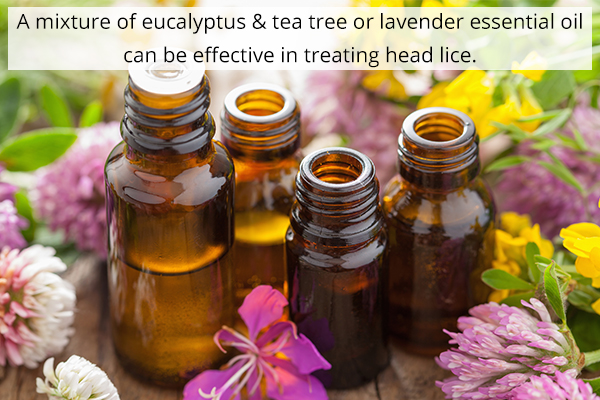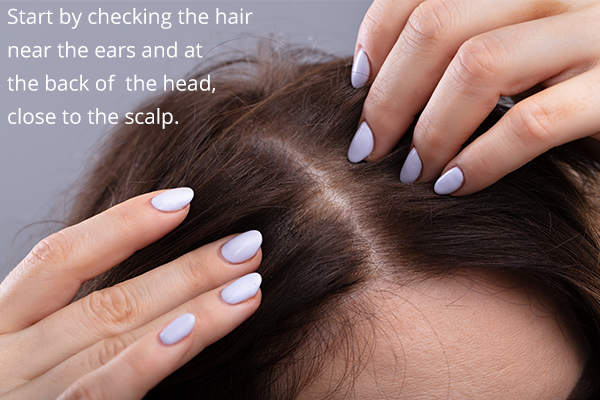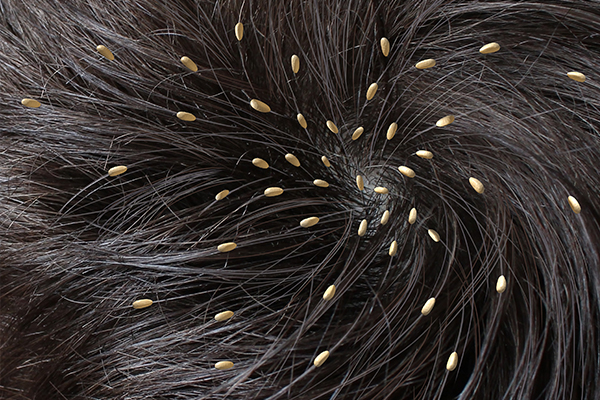In this article:
Head lice infestation spreads at a rapid rate, with high chances of recurrence when not appropriately treated. Therefore, it is important to take steps to control lice at the earliest.

Home Remedies for Head Lice
Use of the following natural products can help treat head lice.
1. Use neem-based products
A study found that a 5-minute application of a neem-based shampoo blocked the supply of oxygen to the eggs, therefore preventing hatching of larvae. (1)(2)
How to use:
Wash your hair with a shampoo containing neem extract to prevent the multiplication of lice eggs.
2. Apply essential oils

A mixture of eucalyptus and tea tree or lavender essential oil can be effective in treating head lice. Eucalyptus oil is found to be an effective, safe, and easy to use alternative treatment for head lice. (3)
Additionally, essential oils obtained from Zingiberaceae species when supplemented with eucalyptus essential oil help kill the nits or eggs, thus aiding lice control. (4)
How to use:
Mix a few drops of essential oil in a carrier oil and dab on your scalp with the help of a cotton ball.
3. Use mayonnaise
Application of mayonnaise prevents transfer of air causing the lice to suffocate.
How to use:
Apply a layer of mayonnaise on your scalp and hair. Wash your hair twice with shampoo after a couple of hours.
4. Apply petroleum jelly
Similar to mayonnaise, a layer of petroleum jelly prevents breathing of the lice. Moreover, it helps kill the eggs as well.
How to use:
Apply a layer of petroleum jelly on your scalp and leave it overnight. Wash your hair thoroughly in the morning.
5. Use coconut oil and olive oil
Applying coconut or olive oil overnight helps to choke the head lice.
How to use:
Apply the oil on your scalp and hair and wrap with a towel, leaving it overnight. Comb your hair in the morning and wash with a tea tree oil shampoo. Repeat treatment once or twice a week.
Note: Since most of the remedies claim to work by suffocating the lice, they may not be highly effective. Head lice, especially their eggs, can live for many hours without air, thus requiring repetitive treatment.
Caution: Avoid using plastic wrap on your head overnight. Instead, place a towel on your pillow to protect the bedding.
Self-Care Tips for Lice Management
The following lifestyle changes and tips can help treat and prevent the recurrence of head lice:

1. Examine the scalp
Start by checking the hair near the ears and at the back of the head, close to the scalp. Furthermore, check the rest of the head while separating hair stands to look closely.
You may observe live lice moving on the scalp or small, white to brown, oval-shaped eggs (nits). Repeat this examination for all family members.
2. Kill the lice
This is important to stop the reproduction of the lice.
3. Remove the nits
Upon killing the live lice, it is crucial to remove the nits to prevent a recurrence. This is done using a special comb.
4. Use treatment products, as suggested
Use OTC treatment products to help solve the problem. Follow the instructions carefully, and repeat the process as directed or required, usually after a week of application. Recheck the heads daily for up to 1 week of second treatment or removal of lice or nit.
5. Clean thoroughly
It is vital to wash and clean all belongings as lice can stay on surfaces for up to 2 days. This includes:
- Wash clothes, towels, and linens. Use hot water for washing, and keep on a hot, dry cycle for around 20 minutes. You may need to wash bed linens more frequently as you may have head lice even after the first treatment.
- Dry clean or store items such as coats, hats, scarves, and stuffed animals in plastic bags for 2 weeks.
- Use hot water and bleach to clean your brushes and combs. Allow the combs to soak in hot water (minimum 130°F) for 20 minutes before washing.
- Wash other hair accessories with hot water or rubbing alcohol.
- Vacuum your carpets, mattresses, furniture, and helmets to ensure proper removal of lice. Dispose of the vacuum bag promptly and safely.
- Vacuum your car, especially the car seats.
What Not to Do
- Avoid applying a conditioner or shampoo-conditioner combination before using a lice medication.
- Refrain from washing your child’s hair for up to 2 days after treatment.
- Do not use pest sprays and fogs in the house, as they have no effect on the lice. They may cause harm upon inhalation.
- Avoid the use of a hairdryer after treatment as some treatments contain flammable ingredients. Additionally, it may blow the lice into the air, infecting other people.
- Do not use a specific medication more than three times. If the medication does not work, consult a doctor.
- Avoid using more than one medication at a time.
- Abstain from using kerosene or gasoline for the treatment of head lice, as they are highly flammable.
Most-Asked Questions About Head Lice

Are head lice contagious?
Head lice are contagious and spread quickly through head-to-head contact or sharing of items such as brushes, combs, bed linens, and hats. Transmission commonly occurs in childcare centers, schools, sports activities, camps, and slumber parties. However, lice do not spread through pets or air.
Do children with head lice need to stay at home?
Children with head lice should avoid school or daycare as they can infect other children. Once the condition is treated, the child is free to return to school or kindergarten.
Can you cure a head lice infestation?
Head lice can be cured with proper treatment and self-care. However, in some cases, treatment becomes difficult as the lice have developed resistance to insecticides and have a high recurrence rate.
How are head lice different from dandruff?
Dandruff refers to the flaking of the skin, which can be easily brushed off from the scalp or hair.
Head lice, on the other hand, need to be pulled from the hair. The nits are attached to the scalp with the help of a glue-like substance and are thus difficult to remove.
Final Word
Preventing the spread of hair lice in children in schools and daycares is a difficult task. However, treating head lice involves simple steps and the application of medicines. Additionally, preventive measures can help avoid re-infestation.

- Was this article helpful?
- YES, THANKS!NOT REALLY


